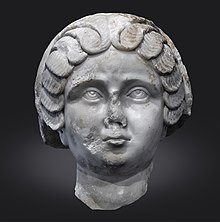Valeria Maximilla
| Valeria Maximilla | |
|---|---|
 Possible portrait, Musée Saint-Raymond.[1] | |
| Empress of the Roman Empire | |
| Tenure | 306–312 (alongside Galeria Valeria 307–311, Fausta 309–312) |
| Born | before 293 |
| Died | after 312 |
| Spouse | Maxentius |
| Issue |
|
| Father | Emperor Galerius |
Valeria Maximilla (fl. 293–312) was a Roman Empress and wife of Emperor Maxentius.
Life
[edit]Maximilla was the daughter of Emperor Galerius and his first wife, whose name is unknown. Around 293 (the exact date is unknown), she married Maxentius, son of Emperor Maximian, in what was likely an attempt to forge an alliance between the families of Maximian and Galerius. They had two sons. The eldest, Valerius Romulus, was born c. 295 and died in 309; the other son's name is not recorded, but might be Aurelius Valerius, who was executed in 312. As an emperor's daughter, she was entitled nobilissima femina.
Maxentius was acclaimed emperor in October 306 against the wishes of Maximilla's father, who unsuccessfully tried to overthrow the usurper in 307. Maxentius remained the ruler of Rome, Italy, and Africa until 312, when Constantine I invaded Italy. Valeria and her husband were together before his defeat at the Battle of the Milvian Bridge, after which she disappears from the historical record. Her fate is unknown.
Valeria Maximilla's portrait does not appear on any of the coinage issued under Maxentius, but she may have been depicted on a defaced sculpture now housed in the Capitoline Museums. If it is of Maximilla, it was likely defaced after her husband's overthrow, when his own images were also defaced.[2]

In St. Catherine's hagiography
[edit]Maximilla may be the nameless queen who appears in the hagiography of St. Catherine of Alexandria by Jacobus de Voragine (one of the fantastic stories in the "Golden Legend"). In this story, the queen converted to Christianity after meeting with Catherine, and the both of them were then tortured and executed by Maxentius, depicted here as a persecutor of Christians.[3]
In another similar version by 15th-century Italian hagiographer Petrus de Natalibus, the queen was named "Faustina". She was accompanied to Catherine's jail by Porphyrius, an army captain. Along with Faustina, the captain and 200 of his soldiers also converted, and they were all supposedly martyred by Maxentius.[4][5] In Eastern Orthodox churches, Faustina, Porphyrius (called a stratelates) and the soldiers share a feast day with Catherine: November 24 for the Russian Orthodox Church, and Nov. 25 for the Greek Orthodox Church.
See also
[edit]References
[edit]- ^ Capus, Pascal (2019). Portrait de Valeria Maximilla (?) (in French). , Musée d’Archéologie de Toulouse. ISBN 978-2-909454-41-2.
- ^ Varner, Eric R. (2004). Mutilation and Transformation (Damnatio Memoriae and Roman Imperial Portraiture). Leiden, The Netherlands: Koninklijke Brill NV. pp. 219–220. ISBN 90-04-13577-4.
- ^ "The Life of Saint Katherine". The Golden Legend or Lives of the Saints compiled by Jacobus de Voragine. Retrieved 7 December 2011.
- ^ Coutts Lindsay (1885). Sketches of the History of Christian Art. John Murray. p. 62.
[From Peter de Natalibus.] Catherine, Virgin and Martyr, suffered at Alexandria under Maxentius the Emperor. [...] the Queen Faustina, his wife, touched with pity, bribed Catherine's gaolers with the assistance of Porphyrius, captain of the host, and came by night to the prison.
- ^ Henry Hucks Gibbs, ed. (1884). The Life and Martyrdom of Saint Katherine of Alexandria. London: Nichols. p. 116.
Peter de Natalibus gives her the name Faustina, under which name, he says, she was canonized, the day of her martyrdom being 9 Kal. Dec. I believe there is no evidence that Maximin had a wife named Faustina; and Maxentius, as I have before said, was never in Alexandria. Archbishop Falconius [Niccolò Carminio Falconi / Nicolaus Carminius Falconius, 18th c.] calls the empress "uxor illa per somnium Maxentii imperatoris."
- DiMaio, Jr., Michael. "Maxentius (306-312 A.D.)". De Imperatoribus Romanis: An Online Encyclopedia of Roman Rulers and Their Families. Retrieved 7 December 2011.
